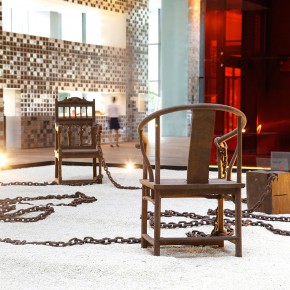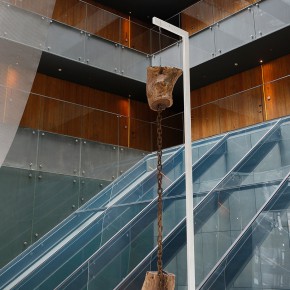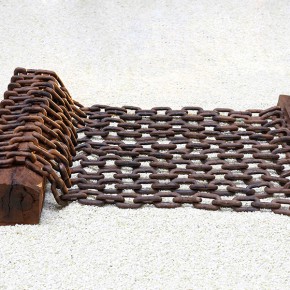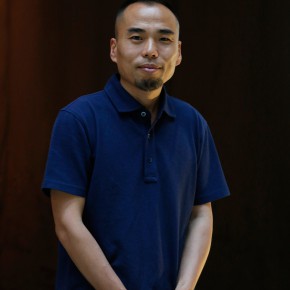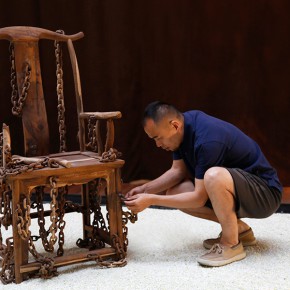
Ye Sen, Sitting and Being Well-versed in the East and the West, Jichi Wood, Dimensions variable, 2011
Packaged within Ye Sen’s work are a series of antitheses: complexity and simplicity; traditional and contemporary; connection and independence; East and West.
Ye Sen’s works are as remarkable for their restraint as for their intricacy. Astonishingly, each of his sculptures begins as a single log. By gradually extracting material, the artist reveals independent objects complete with their interconnecting chains, all born of the same wood and never having existed in isolation from one another. The homogeneity of each sculpture’s origin is often a surprising revelation to the viewer, notwithstanding that the clean, unadorned surfaces make no attempt to disguise the uniform materiality of the wood.
Ye Sen’s body of work is informed by traditional Chinese philosophies and carving techniques, through which the wood itself expresses its potential to the artist. Venerable Chinese craftsmen considered the materials with which they worked to possess unique voices, which when observed, revealed their artistic possibilities. These traditional concepts are demonstrated by Ye Sen’s obvious affinity with wood, but he also overlays the voice of the material with his own notions concerning contemporary society. The carved chains, which both enable and constrain movement, are symbols of the restrictions that society and personal habits enforce upon our thoughts, particularly in cross-cultural contexts. But they also represent connection, in the sense of our shared humanity.
The concept of shared origins, fed into the human construct of East and West, is particularly apparent in Seated: China – West. A Ming dynasty round-back armchair and a Victorian period palace chair take up their metaphorical roles in opposing corners. Each is a culturally distinct manifestation of the same object made from the same material. The length of chain permits distance between the two chairs, but also constrains them within an ambit. Facing each other directly, with curiosity or perhaps suspicion, they are familiar and yet unfamiliar with one another’s existence. Also chained within the work are remnant slabs of the log from which each chair was created, serving as a persistent reminder of their origin and interconnectedness.
10 July 2014, Brian Wallace in Red Gate Gallery
Ye Sen’s reflections: Crafting the Inner Life of Timber, an exhibition initiated by Red Gate Gallery and displayed at the Opposite House, presents four carved timber installations. The works deal with the existence of contemporary art in public spaces and issues related to construction by the masses. In addition, these works demonstrate the refinement of my own creative practice over nearly two years.I hope that my works speak meaningfully to the audience. As Professor Qian Mu once observed, “scholarship comes from the people”. This observation has inspired me, helping me to understand the spirit of “the conversion of traditional language” in artistic experimentation from which my early successful works were derived. Two of the objects I found on stalls at the Panjiayuan Market in Beijing --- “fluffing” (xiabai, a stool pillow), and the “bergamot prop” (foshoutuo, a flower pot frame) --- were some of the most basic craft work done by traditional carpenters as folk artists, and the basic information that they conveyed to me was that “timber is alive”. I felt compelled to experiment with handling timber as a material, and these experiments demonstrated for me “the materialistic rendering of artistic expression”. I realized that the concept of transforming materials was one which had roots in ancient Chinese wisdom, which considered a material object to possess a voice. So, when I fix my gaze on each piece of timber in preparation to create, I am thinking both in terms of traditional techniques of carpentry and carving, and traditional Chinese concepts. I look beyond the purely aesthetic discipline of connoisseurship, and consider the opportunities presented to me by the capacity of the material.
The four works in this exhibition were separately conceived from complete logs. Appropriate sections were selected for the planar and relief carving of one or more connected pieces that could never be separated or even disconnected, with the aim of transforming what was originally a holistic state into one that is potentially dynamic and alive.
Blind comprises a horizontal log that has been hand-carved using various techniques to fashion a ten-meter-long relief chain, enabling it to hang like an ancient vertical scroll painting. Analysis No. 3 is the middle section of what was once a log that has been relief carved into a continuously connected three-meter-long wooden chain that extends the length of the original log.The main conceptual significance of Seated: Sitting and Being Well-versed in the East and the West reminds us of the thinking framed by the notion that “East is East, and West is West and never the twain shall meet”. It was made by carving a whole block large enough to fashion from it one Ming dynasty round-back armchair and a contemporaneous Victorian period palace chair, the arms and footrests of which are connected by long continuous, and never disconnected, relief-carved wooden chains.
A Craftsman's Analysis of A Chair comprises a whole log hand-carved using wood carving techniques to prepare all the components of the Ming-style “official’s hat chair”. The components are connected to the wooden log from which it was carved by a continuous and unbroken relief-carved wooden chain strung so that the chair can never be separated from the remaining log. The Record of Examination of Craftsmen (Kaogong Ji) states that “those with knowledge and talent create artifacts, those skilled in handicrafts pass them on, for the generations to follow, and all this constitutes craft”. In the process of being engaged in the artistic creation and production of these carved timber objects, I have gradually also reflected and introspected on my own identity, even though my conscious perceptions might differ slightly from those of the ancients... ...1 July 2014, Ye Sen in Wangjing
Translated by Dr Bruce Gordon Doar
Curator: Brian Wallace
About the exhibition
Duration: Jul 6 - Sep 30 2014
Venue: The Opposite House
Add: Taikoo Li Sanlitun North, No. 11 Sanlitun Road, Chaoyang District, Beijing
Courtesy of the artist and Red Gate Gallery, for further information please visit www.redgategallery.com.



